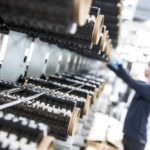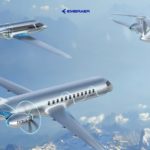Engine manufacturer Pratt & Whitney will be an event partner at the Sustainable Skies World Summit next week which charts the industry’s progress towards reducing emissions.
Graham Webb, Pratt & Whitney Chief Sustainability Officer, who coordinates the execution of Pratt & Whitney’s sustainable propulsion technology roadmap and strategy, will be presenting a session on Pratt & Whitney’s perspective on roadmap to Net Zero aviation on April 5, at the event which takes place at the Farnborough International Exhibition & Conference Centre.
Frank Preli, Pratt & Whitney Vice President Propulsion & Materials Technologies will join with speakers from Embraer, Airbus, GE Aviation, Boeing, McKinsey & Co and Rolls-Royce for a panel session “Hybrid electric & hydrogen: What will future engines and aircraft technology solutions be and by when?”
FINN spoke to Webb and Preli about how the company was reducing its own emissions and how it would be helping the industry achieve the same.
How has Pratt & Whitney worked to reduce its own emissions over the past year?
GW: Pratt & Whitney’s commitment to powering sustainable aviation is demonstrated in our investments in new technology, materials and products that require less fuel through increased engine efficiency, including hybrid‐electric technology. We call this strategy Smarter. Cleaner. Greener. In the past year, we launched the GTF Advantage engine ‐ this engine decreases fuel consumption and CO2 emissions by 17 per cent compared to prior‐generation engines.”
including hybrid‐electric technology. We call this strategy Smarter. Cleaner. Greener. In the past year, we launched the GTF Advantage engine ‐ this engine decreases fuel consumption and CO2 emissions by 17 per cent compared to prior‐generation engines.”
“Just last month we successfully tested the GTF Advantage engine running on 100 per cent SAF, and we’re working on making our engines ready to operate on 100 per cent SAF. We also continued work on the regional aircraft‐scale hybrid‐electric demonstrator ‐ a $163 million project – supported by the governments of Canada and Quebec, and in partnership with Collins Aerospace and De Havilland Canada. With this demonstrator, we are targeting a 30 per cent fuel efficiency improvement compared to today’s best turboprops, with flight testing planned for 2024.”
“In our operations, we have established goals to reduce greenhouse gas emissions, water usage and waste, targeting a 10 per cent reduction by 2025, compared to 2019. Our efforts over the past year are trending favourably to these targets.”
FP: “Pratt & Whitney continues to improve engine efficiency to reduce fuel consumption and emissions. The geared engine architecture enables higher propulsive efficiency, and we are working with the Federal Aviation Administration (FAA) on even more efficient technologies. We also continually improve the thermal efficiency of our engines, particularly with advanced materials such as ceramic matrix composites (CMCs). In the past year we opened a 60,000 square‐foot R&D facility in Carlsbad, California, dedicated to CMCs.”
“In partnership with NASA, we started developing advanced high pressure turbine technologies that will reduce fuel consumption and emissions for next generation single‐aisle aircraft. And most exciting, we recently were selected by the US Department of Energy to develop novel, high‐efficiency hydrogen-fuelled propulsion technology for commercial aviation.”
… and what are the plans for the next 5 years?
GW: “We’ll continue our efforts with Collins Aerospace to mature hybrid‐electric technologies so that it can be applied across different aircraft segments, from general aviation, to helicopters, to single‐aisle aircraft. We’ll also keep working with regulators to have standards for 100 per cent SAF and support the infrastructure needed to bring it to scale while continuing to develop and mature our HySIITE hydrogen-fuelled steam injected intercooled turbine engine technologies.”
FP: “We’ll likely be looking at materials that are even lighter than what we have today, developing low emissions combustion technology, demonstrating electrification technologies and working on hydrogen propulsion engine architectures that will exploit the properties of liquid hydrogen. At Pratt & Whitney we say that ‘sustainability starts with the gear’ – our GTF engine architecture has a long runway for growth, so we’ll continue improving engine efficiency with further advancements to our geared turbofan.”
Why was it important for Pratt & Whitney to take on the role of event partner at the Sustainable Skies World Summit?
GW: “In October 2021, Pratt & Whitney joined an industry‐wide commitment to achieve net zero air
transport carbon emissions by 2050, in support of the 2016 United Nations Framework Convention onClimate Change’s Paris Agreement 1.5ºC goal. We have a solid strategy to make sustainable aviation a reality, so we are excited to share it at venues such as the Sustainable Skies World Summit.”
FP: “Pratt & Whitney is a world leader in the design, manufacture and service of aircraft and helicopter engines, and auxiliary power units, so the industry – and the flying public – look to us to continue making improvements to our products so that we can help mitigate aviation’s impact on the environment. Venues such as this Summit, provide us an opportunity to highlight our technologies and advancements, as well as seek out those public and private partnerships that will enable future technological advancements.”
Graham Webb, CSO will be delivering a keynote on ‘Pratt & Whitney’s perspective on roadmap to Net Zero.’ Can you give a brief overview of some of the key topics which will be covered?
GW: “During my keynote, I’ll highlight Pratt & Whitney’s pathways to supporting our, and our customers’ net zero commitments, including the continued development of revolutionary technologies such as the next generation of geared turbofan engines, hybrid‐electric systems, and hydrogen fuel. I’ll also share our perspective of getting to net zero aviation: advancing the availability and use of cleaner fuels such as SAF, and protecting the environment through greener and more efficient manufacturing and operations.”
As well as the roadmap, Francis Preli will be talking timelines within his session ‘Hybrid electric & hydrogen: what will future engines and aircraft technology solutions be and by when?’ Can you name some of the key challenges the industry will have to tackle as it moves towards “when” these technologies can be implemented?
FP: “Pratt & Whitney’s sustainability strategy has three key areas of focus. First, our engines are certified to operate on up to 50 per cent sustainable aviation fuel (SAF) today and soon, operation with 100 per cent SAF will be validated. The challenge is to develop the production infrastructure to provide the SAF. We will see significant progress in the coming years as a specification for 100 per cent SAF is established.”

“Second, we are developing the needed technologies to add electrification elements to both small and large engines. We envision 50 per cent electric‐hybrid propulsion systems for the regional airline market and 5‐10 per cent electric‐ hybrids for the narrow‐body airliner market. Current challenges are the weight and volume of battery systems. Flight demos will be completed in the next few years and production engines could be available in the 2030‐2035 timeframe.”
“The third element of the strategy is the development of technologies and engine architectures optimised for operation on alternative fuels such as hydrogen. Many challenges remain, including green hydrogen production capacity, delivery and fuelling infrastructure and the need for new aircraft and engines. We may see flight demos in the next several years.”
For the full agenda for the Sustainable Skies World Summit 2022 click here

